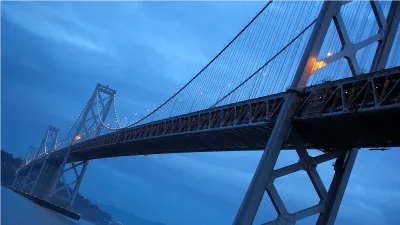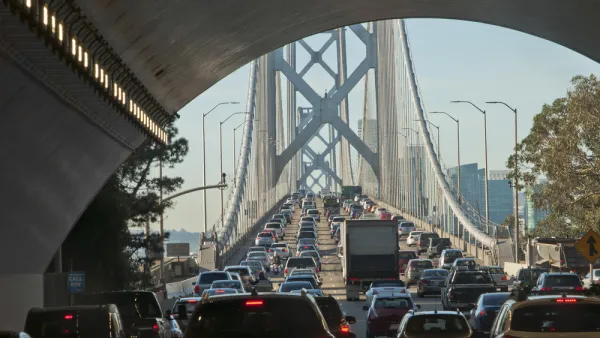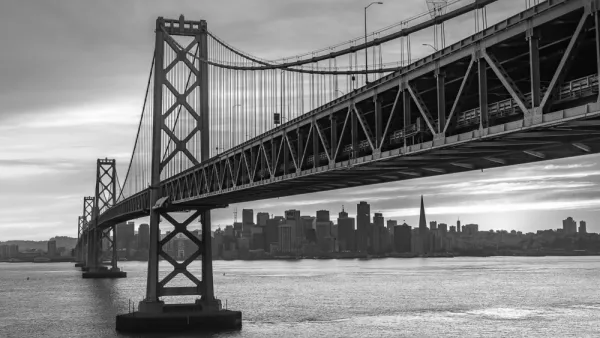Before the ballot measure would go to voters, state legislation needs to be written, passed, and signed by Gov. Brown. The first step was taken Dec. 14, when the region's planning agency discussed the option. Tolls are $5, last raised $1 in 2010.

"At a workshop meeting Wednesday at the Hyatt Regency Hotel in San Francisco, the Metropolitan Transportation Commission [MTC] discussed the notion of persuading the state Legislature to create Regional Measure 3 — a ballot measure to increase tolls — for voters’ consideration in 2018," writes Michael Cabanatuan, transportation reporter for the San Francisco Chronicle.
At this point, Regional Measure 3 is little more than a vision. Unlike sales taxes or bond measures, counties can’t place a toll increase and spending plan on a ballot. That requires action by the Legislature, and the commission hopes to persuade lawmakers to grant them that authority in 2017.
Seven of the Bay Area's eight toll bridges are state-owned and managed by MTC, though it calls itself the Bay Area Toll Authority in that capacity. The Golden Gate Bridge is owned and operated by the Golden Gate Bridge, Highway and Transportation District.
Tolls are relatively low compared to the nation's most expensive crossings: none ranked among the top 12. [Go through the slide show.] The busiest bridge, the Oakland to San Francisco Bay Bridge, charges $4 to $6 depending on time of weekday. On weekends, the toll is $5, as are the six other state bridges seven days a week as they are not congestion-priced. See MTC toll schedule [PDF] for additional rates.
The electronic toll on the Golden Gate Bridge is $6.50 (or $7.50 by license plate), Like the state-owned bridges, the toll is charged in one direction.
Projects
In addition to determining how much to ask voters to hike tolls, expand congestion pricing to the six other state-owned bridges, discount tolls paid electronically, and increase truck tolls, projects would need to be selected.
"A spending plan still needs to be developed, but Dianne Steinhauser, executive director of the Transportation Authority of Marin, hoped dollars could be included for a trio of large county projects," reports Mark Prado, environment and transportation reporter for the Marin Independent Journal.
“This could help us finish the Novato Narrows widening project and build a connector from the Richmond-San Rafael Bridge to Highway 101,” she said.
"Oakland Mayor Libby Schaaf said the potential measure should direct funding to affordable housing, and bicycling advocates argued that it should pay for construction of a bike path on the west span of the Bay Bridge between Yerba Buena Island and San Francisco," adds Cabanatuan.
Voters in seven Bay Area counties last voted to increase tolls by $1 in 2004 when they approved Regional Measure 2. With a few notable exceptions, including funding a fourth bore for the Caldecott Tunnel, projects were largely transit-based. The 2010 toll increase was authorized through legislation to fund seismic retrofit of the bridges.
Like the prior measure, Regional Measure 3 would need to pass with only a majority vote, unlike the sales and property taxes on the Nov. 8 ballot. Prado writes that the vote would be held in all nine Bay Area counties, unlike the March 2004 vote which was held in the seven counties that had 'landings' in or near the seven bridges.
FULL STORY: Ballot measure could raise bridge tolls to fund transportation

National Parks Layoffs Will Cause Communities to Lose Billions
Thousands of essential park workers were laid off this week, just before the busy spring break season.

Retro-silient?: America’s First “Eco-burb,” The Woodlands Turns 50
A master-planned community north of Houston offers lessons on green infrastructure and resilient design, but falls short of its founder’s lofty affordability and walkability goals.

Delivering for America Plan Will Downgrade Mail Service in at Least 49.5 Percent of Zip Codes
Republican and Democrat lawmakers criticize the plan for its disproportionate negative impact on rural communities.

Test News Post 1
This is a summary

Test News Headline 46
Test for the image on the front page.

Balancing Bombs and Butterflies: How the National Guard Protects a Rare Species
The National Guard at Fort Indiantown Gap uses GIS technology and land management strategies to balance military training with conservation efforts, ensuring the survival of the rare eastern regal fritillary butterfly.
Urban Design for Planners 1: Software Tools
This six-course series explores essential urban design concepts using open source software and equips planners with the tools they need to participate fully in the urban design process.
Planning for Universal Design
Learn the tools for implementing Universal Design in planning regulations.
EMC Planning Group, Inc.
Planetizen
Planetizen
Mpact (formerly Rail~Volution)
Great Falls Development Authority, Inc.
HUDs Office of Policy Development and Research
NYU Wagner Graduate School of Public Service





























